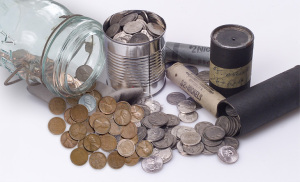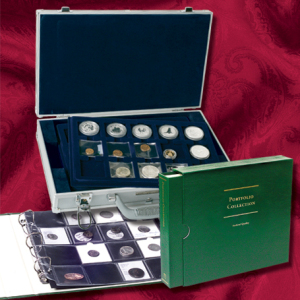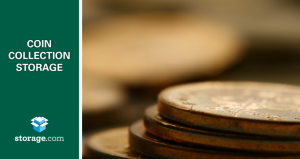Keeping your coins safe is as easy as 1-2-3!
You put valuable time, effort and money into your coin collection. So when it comes to keeping it safe, knowing how to best protect it is important! There are many good choices out there, so deciding what’s right for you can seem daunting. With that said, let’s take a look at what can harm your coins, and how you can best protect your collection from those harmful elements!
 1: What can harm my coins?
1: What can harm my coins?
For starters, any extreme temperature – hot or cold. Do you store your collection in a basement or an attic? Though these might seem like great spots for quick and easy storage, often neither location is adequately ventilated or insulated (at least, not for the purposes of coin storage). Plus, basements are known for being damp, while attics can run very dry – and neither is a good environment for your collection. The best place to store your coins is in a moderately cool, dry place. A good rule of thumb is that if the climate is comfortable for you, it’s right for your coins, too.
Keep in mind too, that where you live in the country can make a difference. For example, here in New England, we see a wide temperature swing during the seasons. Summer months can be really hot and humid, while the winter months bring extremely cold temperatures. If you live in more southern parts of the U.S., your temperatures may be more steady, but humidity may still be a concern. Keep your climate in mind when deciding where (and how) you want to store your collection.
Certain elements can also react with (and harm) your coins. PVC (polyvinyl chloride) is something that should be kept far from your collection. A chemical used to make plastic softer and less brittle, PVC was once found in soft plastic coin flips. However, an acidic reaction occurs when coins come in to contact with PVC. Before long, your coins are sporting greenish, grey or milky white streaks – the iconic “green slime” of PVC residue. Over time, this can cause permanent damage to the coin’s surface. Luckily, the modern, more rigid mylar flips do not contain damaging PVC.
2: Securing individual coins & collections
How you choose to display and secure your coins depends on what’s in your collection and your individual preference. The most popular choices are:
-
- Albums & folders – If you’re building a collection of a specific coin series, these coin books are a handsome way to both organize and display your coins. Littleton offers a line of archival-quality 3-ring binder albums – most laid out to fit a complete date and mint mark collection for a series. If you’re just getting started, custom coin folders are a good option. They lay flat and generally hold one coin from each year of issue (or each different design) for a series. Both the albums and the folders offered by Littleton are made from archival-quality materials that will keep your coins safe.

My loose coins are in holders… what’s next?
If you’ve decided to store individual coins in Air-Tite holders or 2×2 holders, you can still organize a collection! Coin cases offer a handsome way to carry and display coins in either type of holder. Personal collection albums also come in a variety of options – and most accommodate coins held in 2×2 holders.
- Air-tite holders – These archival-quality holders offer a clear view of your coin, and are great for securing individual pieces. You can choose from direct-fit air-tite holders, which are made to fit a coin’s diameter, or those with a foam rubber ring, which secures the coin in place.
- 2×2 holders – named for their dimensions (2″x2″ square), these come in two different archival-safe options. Mylar-lined cardboard holders have a clear window to display both sides of your coin. Mylar flips allow your coin to move around, but they also have an opposing window where you can insert a label or story card, and still view your coin. These holders are another good option for individual pieces.
- Plastic tubes – if you buy coins in rolls, or have several of the same denomination to store, chemically-safe coin tubes make a great way to protect them from the elements.
- Certified coin holders (slabs) – Generally reserved for pricier or higher grade coins, slabs are sonically-sealed, rigid plastic holders offered by third-party grading services like PCGS or NGC. Once a coin is slabbed, it’s sealed in a permanent, long-term holder that also bears a label with information about the coin, including its certified grade. If you have some coins that are certified, and would like the same sleek look for the others in your collection, archival-safe Lighthouse Slabs offer a more affordable option.
Regardless of how you ultimately decide to store your collection, always remember: the safest way to handle a coin that isn’t in a holder, is with the use of soft cotton gloves. They’ll protect the coin’s surfaces from the naturally-occurring oils in your skin, which can be harmful over time.
3: In-home or off-site storage?

For more information on storing your collection, check out this article from storage.com.
While it’s your safest bet, storing your collection in a bank’s safe deposit box may not be the most economical choice. Though it may be an added expense, these vaults are specially designed to prevent theft and fire damage. However, be aware of the fact that many use a vapor to control the temperature inside the vault, making for a more humid environment. This can be solved by placing silica gel packs in with your collection. Just be sure to replace them a couple of times each year to ensure they’re working at their best.
Short of renting a bank deposit box, you can also purchase a home safe for your own personal use. Again, you’ll want to pay attention to what your safe is constructed from, and where you locate it. Make use of silica gel packs if moisture is a concern.
Though it takes some thought and planning, it’s still worth the time and energy to decide how you’d like to keep your coin collection safe. Do you take any steps to protect your collection that I didn’t discuss above? Let me know in the comments below – your ideas may help another collector, too!




I want to display my coins by year instead of by denomination. Are there any albums or other devices that are made for this means of displaying coins?
My goal is to gather every coin that is circulatable (i.e., no proof coins) for the years from 1960 and continuing and put them, year by year, into pages similar to your albums. I’ve not seen any collections (I’m new at this, however) that do this.
I think I can design some containers (for lack of a better word) for every year but I wonder if the market place has already done this.
This is a beautiful hobby, and I enjoy Littleton catalogs and advertisements. Your catalogs are endlessly fascinating.
Thank you, Kurt Klein
Hi Kurt, Collecting by year is an interesting way to build a collection. Our albums and folders are mainly designed to collect by series, date and mint mark. It sounds like the US Mint sets may be right up your alley. These have all the coins issued for circulation from both the Philadelphia and Denver Mints. They are pre-packaged from the US Mint and will fit nicely in storage boxes. Hope this helps. Enjoy your day! ~Erin
I also collect by year of issue. for the 21st century I have mint proof sets. I am also into collecting the entire 20th century. I have separate displays for dollar half dollar and penny coins. I use the Littleton 60 coin album to display 2×2 nickel dime and quarters by year
Excellent choice Dennis! Thank you for being a Littleton customer! Have a great day. -Rick
I have only just started collecting and currently my coins are displayed in a glass cabinet in my living room. The coins are in the plastic cases they came in, is there any problems in displaying my collection this way?
Hi Stephen, sounds good! Just be sure you keep the collection in as moderate a temperature and humidity as possible (metal & moisture is a bad combo!) and that the coin holders & cases you’re using are archival quality-meaning the don’t have any acids, glues or material that may cause damage to the coins over time. Happy collecting! -Rick
Hello,
Love your website and offerings. Question. I am too am new to collecting but have all sorts of items, Kennedy halfs in one of your velour cases in 2×2, I have slabs in the intercept boxes and I also have some paper currency in your plastics folders as well as some loose 2×2’s with various denominations. I won’t display them and I have a place in my house I can keep them so there are no temperature swings but want to store then in something(like a bin) so they are all in one place and not just all over the place. Any thoughts, meaning is a plastic bin ok, or a metal box, etc. I know all those could cause havoc on coins potentially but there will already be in protected supplies. Any thoughts?
HI Jeff welcome to the exciting hobby of coin collecting. It sounds like you have your coins pretty safely stored. As long as they are already in tubes, flips, capsules, etc there should be no problem storing them in some kind of tote or bin (metal or plastic). I hope that helps. Have a great day! -Rick